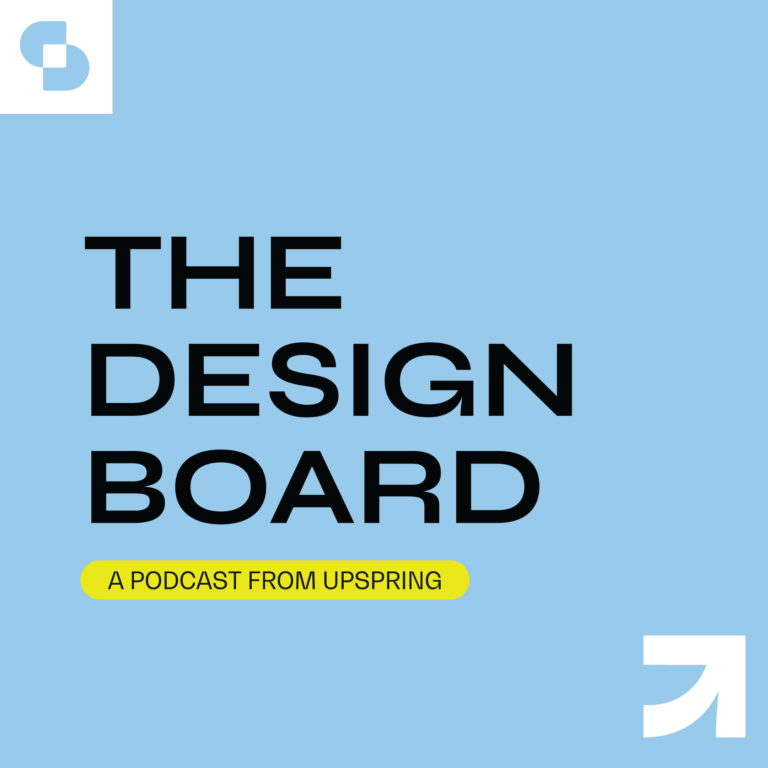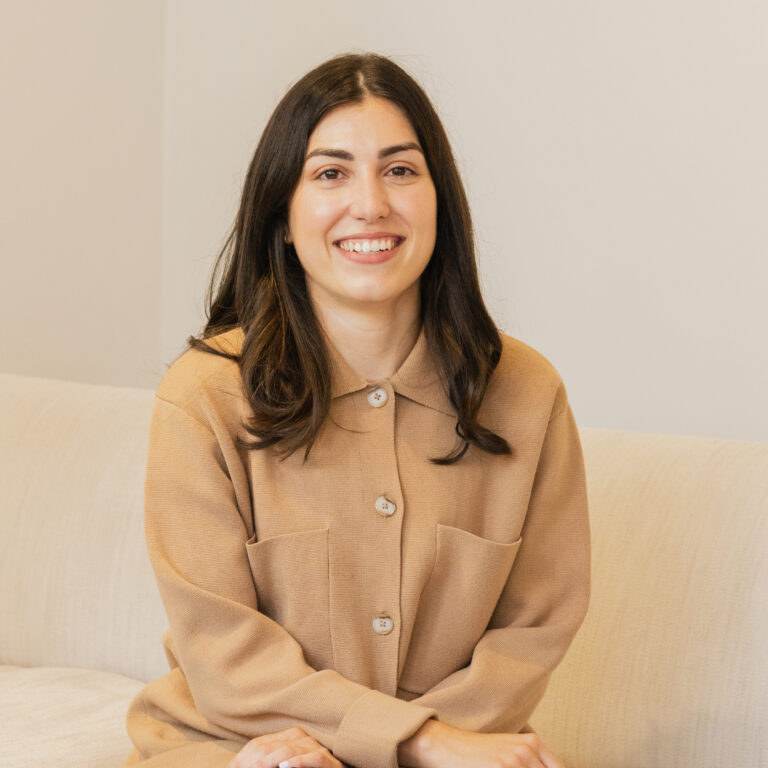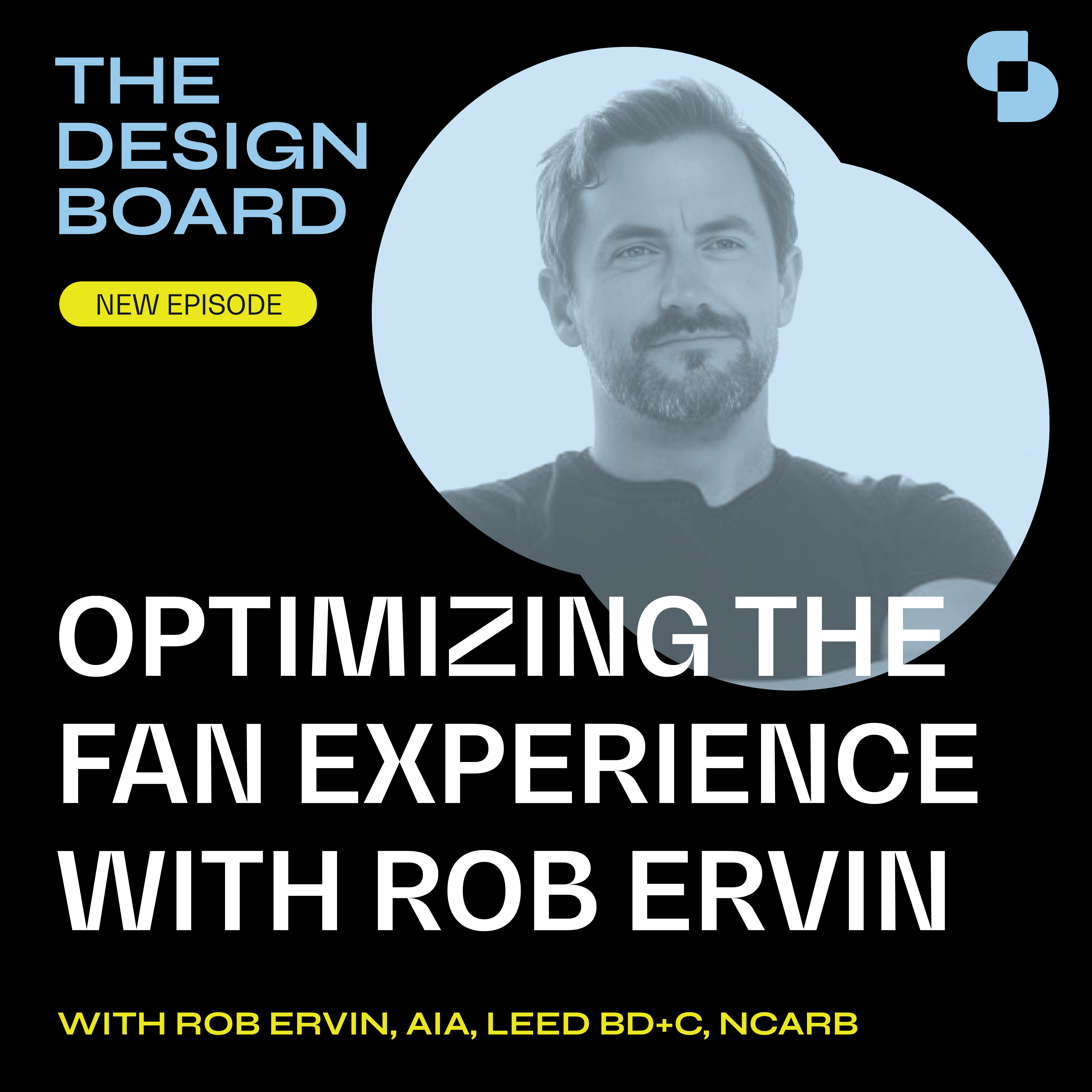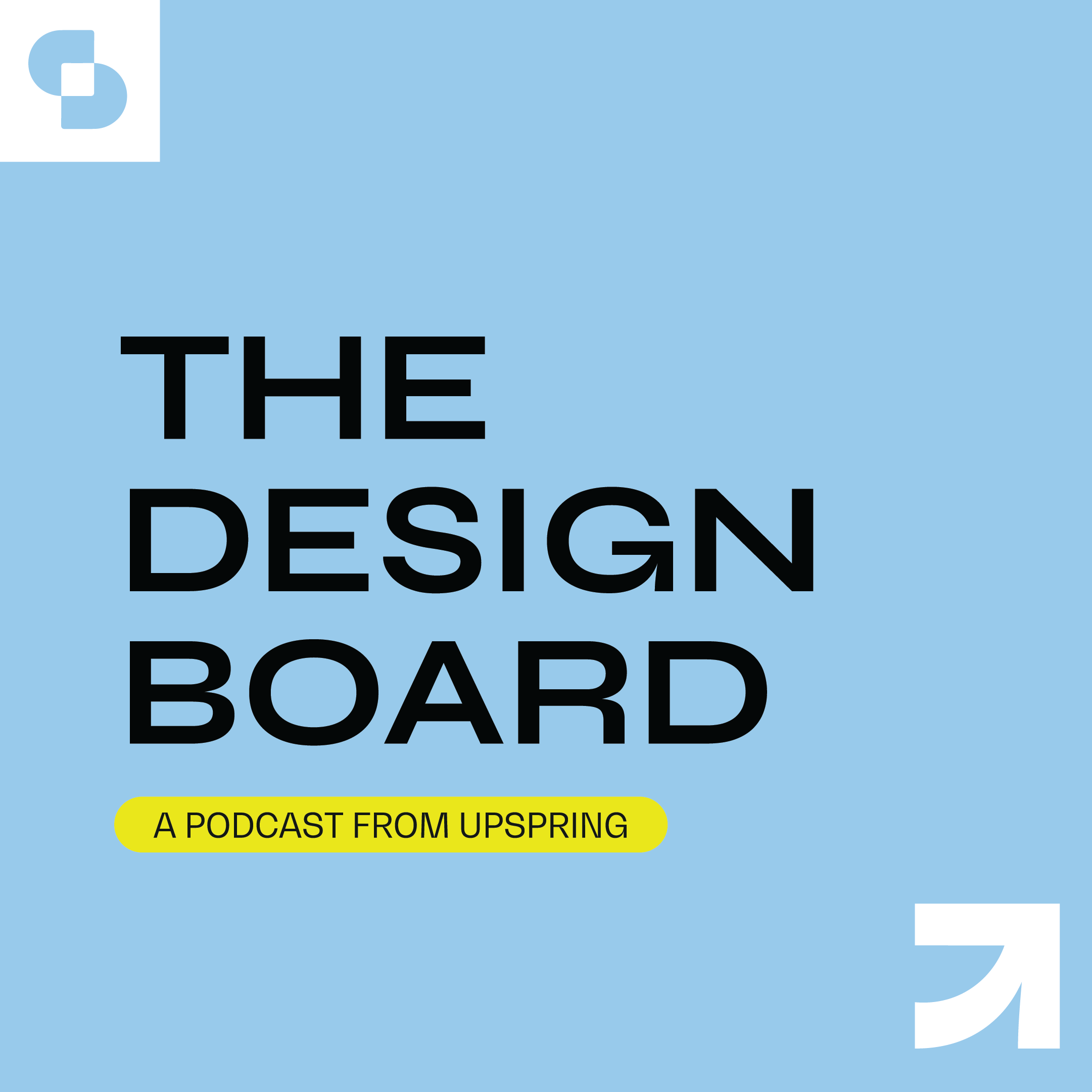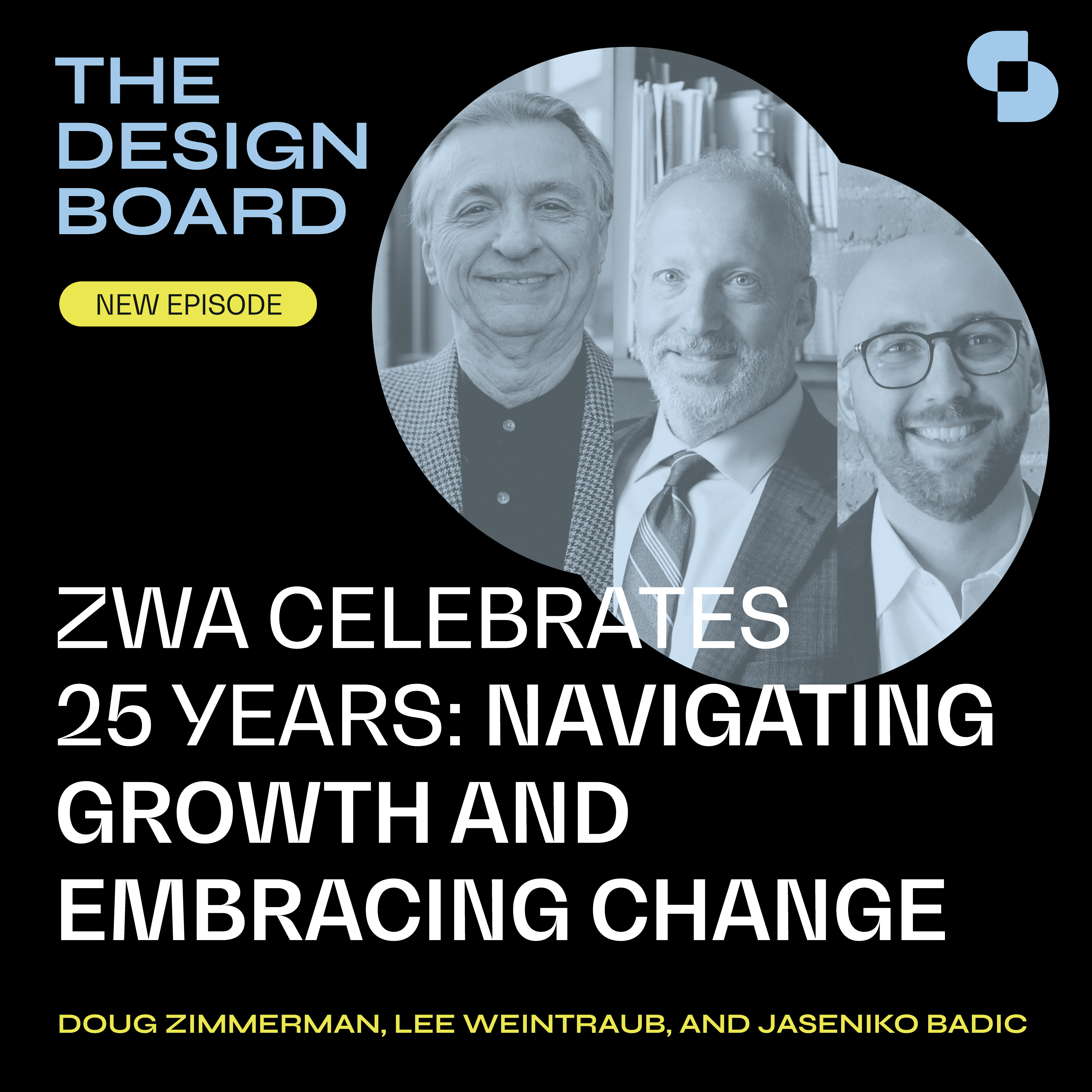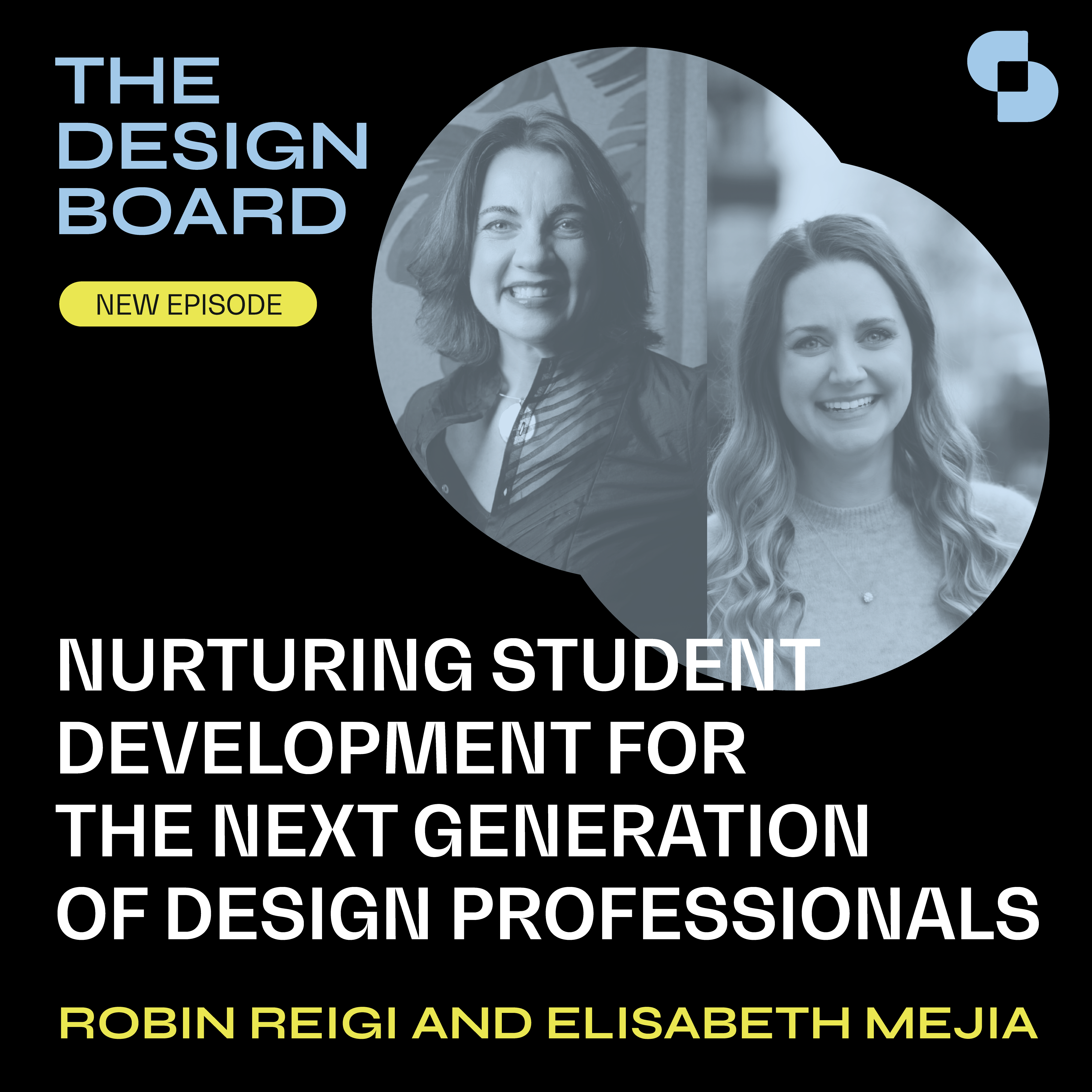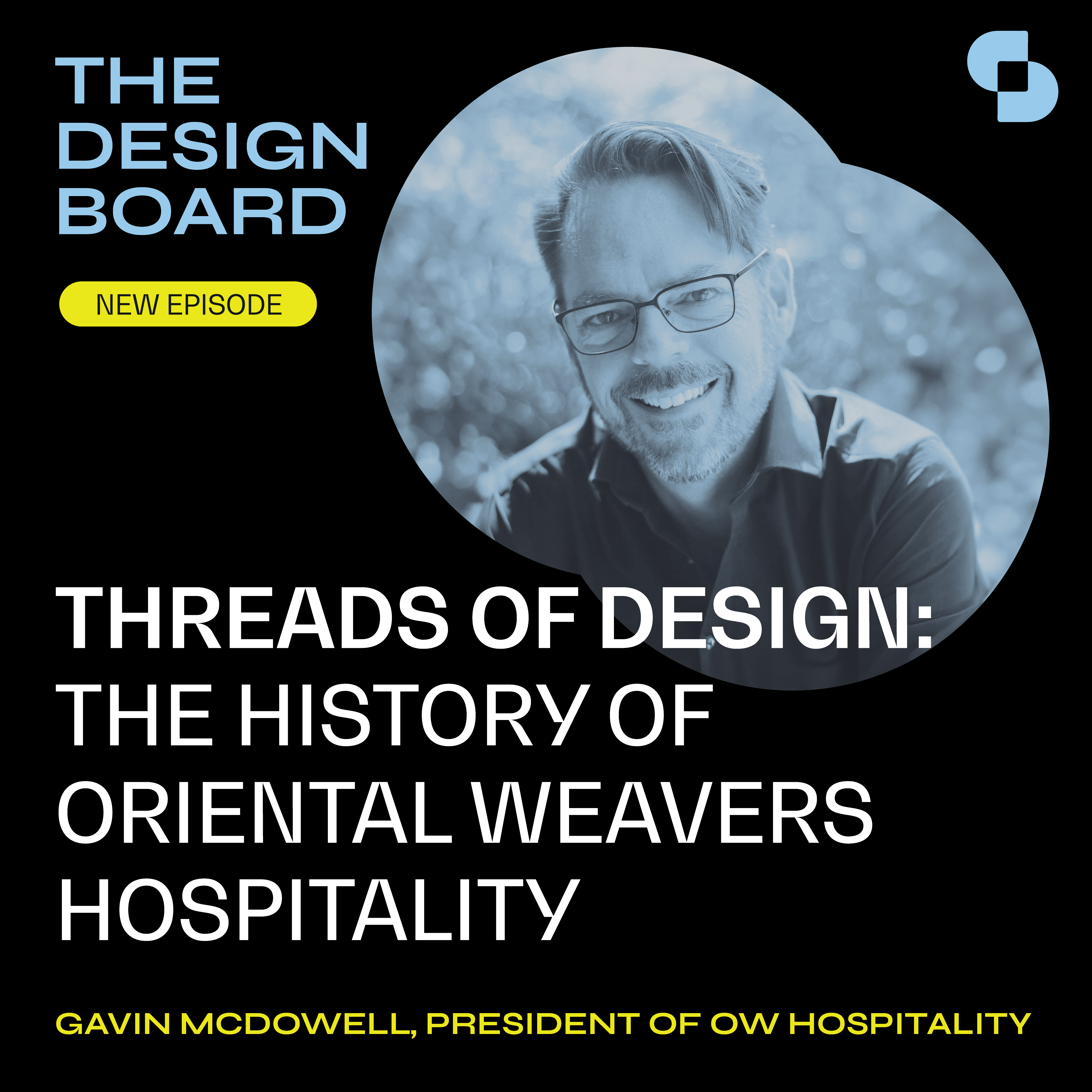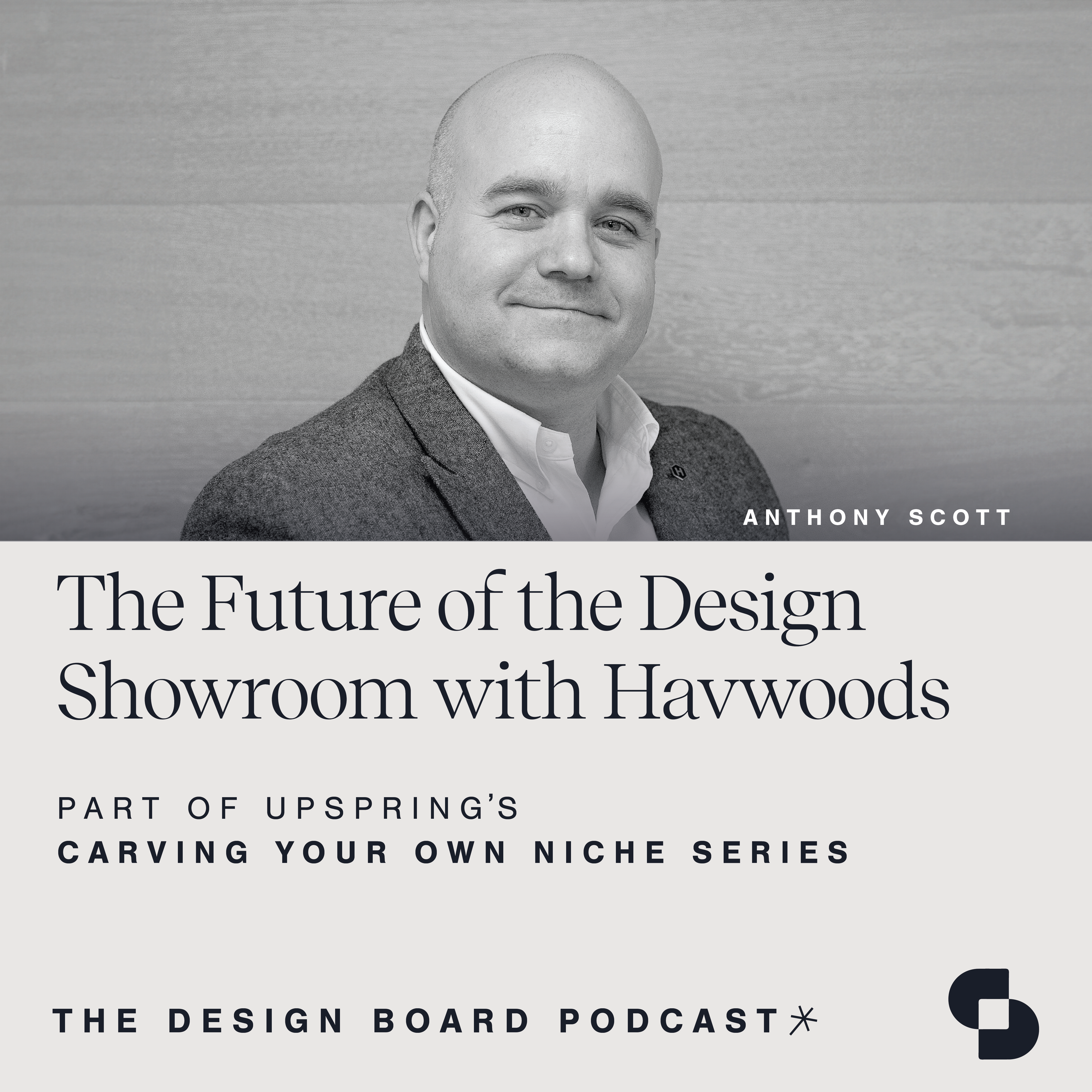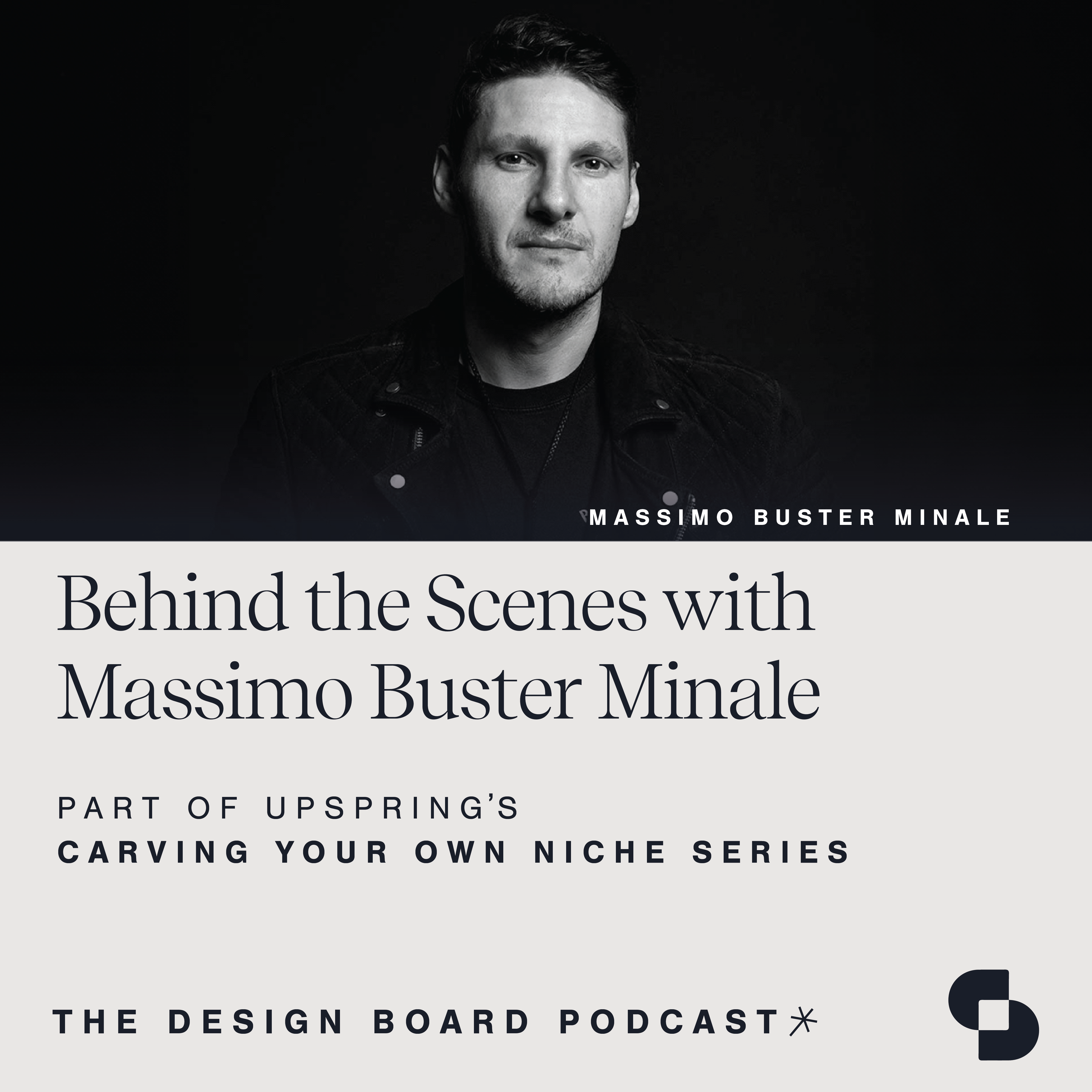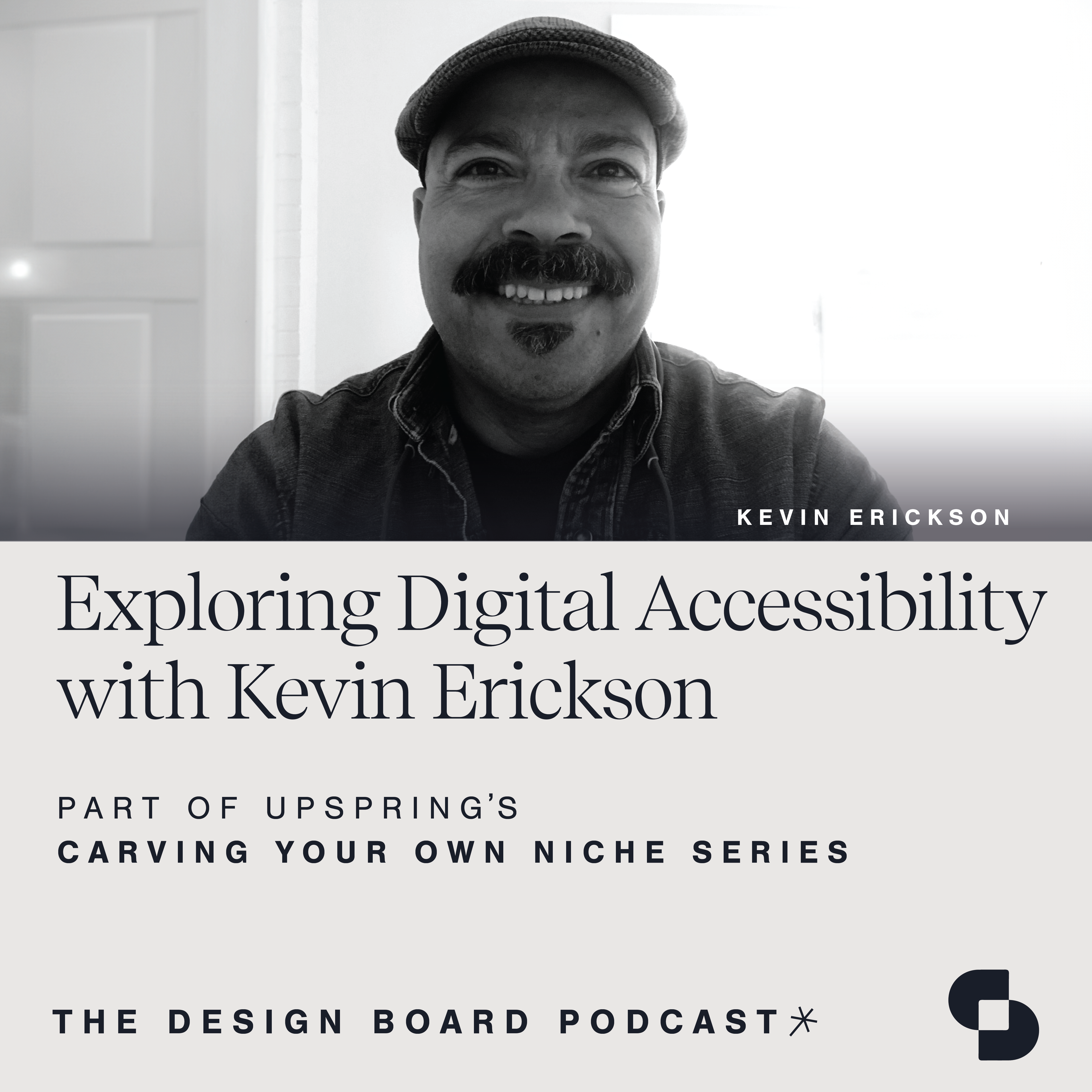Join Caroline Saba and Amanda Schneider, founder and president of ThinkLab, as they dig deep into how design thinking and consumer market research can be used to uncover solutions for various challenges we’re facing in the industry.
The Design Board, by UpSpring, is a proud member of SANDOW Design Group’s SURROUND Podcast Network, home to the architecture and design industry’s premier shows.
The Design Board, by UpSpring, is a proud member of SANDOW Design Group’s SURROUND Podcast Network, home to the architecture and design industry’s premier shows.Speaker 1:
Welcome to The Design Board, a podcast created by the team at UpSpring that focuses on design, development and everything in between. We invite innovators in our industry and explore topics that support your growth in every way. The Design Board is a proud member of SURROUND, a podcast network from SANDOW Design Group featuring the architecture and design industry’s premier shows. Check it out at surroundpodcast.com.
Caroline Saba:
So welcome back to The Design Board podcast. I’m so excited to have this conversation today as we’re going to dig deep into how design thinking and consumer market research can be used to uncover solutions for various challenges we’re facing in the industry. We’ll be chatting about hackathons, personas and everything in between, but first for starters, I’m going to do some quick introductions. I’m Caroline Saba, an Associate Vice President here at UpSpring. I manage and help execute strategy for many of our architecture and design firm clients, as well as our B2B product manufacturers. I am joined by the lovely Amanda Schneider. Amanda is President at ThinkLab, the research division of SANDOW, and host of Design Nerds Anonymous podcast. She is a researcher, writer, and strategic thinker with a strong background in industrial design, market research, and product management. Amanda, thank you so much for joining us today.
Amanda Schneider:
Thanks so much. I’m excited to be here.
Caroline Saba:
Yay, I’m excited to have you. I’ve long admired Amanda for all of her critical thinking over the past few years, so this is going to be a fun conversation. So to get started, I want to give our listeners some additional context into ThinkLab. So ThinkLab is a research firm in the design industry. Can you give us a little insight into what that means and what you do?
Amanda Schneider:
So while a lot of companies outside of the design industry are very accustomed to having market research and market research functions, I will say as a creative industry, we often run on gut here. So we sought out to start the industry’s first ever market research company specifically for the design industry. And we typically work on behalf of manufacturers and distributors to study why designers make the decisions they do. And then in turn we kind of leverage that insight to help our product partners do better for the designers that they serve. We know that product is really kind of a critical part of the design process and you can have the most beautiful space, but if you can’t find the right products to fill it, it’s a huge challenge. So our goal is really to bridge that gap. Now our work, just to give you a little bit more detail, ranges across a number of different functions.
We do a lot of benchmarks for the design industry. Some of those are free, some of them are a part of our subscription program. We do custom research, so whether you want us to take product out for a view to make sure it’s going to hit the mark, or brand studies, or help you look into a new product category, we do a lot of custom research. We also do a lot of thought leadership for the industry. You mentioned Designer Nerds Anonymous, which was our inaugural podcast that is now in the top 5% of podcasts. So if you haven’t given that a listen, please do.
But we also launched the industry’s first ever CEU Podcast and we have another one really focused on empowering reps, that was a joint venture with Material Bank, it’s called Mpowered, really focused on that business development for reps. And then the last piece of what we do, I would say is something called hackathons, which has been really fascinating, especially with the pace of change over the last couple of years to really leverage design thinking and our research processes to cover and tackle some of the industry’s biggest hairiest challenges.
Caroline Saba:
I love that. So many things cooking over there. Let’s dive into those hackathons a little bit more. Can you walk us through what that is?
Amanda Schneider:
So a hackathon is no small undertaking. It’s about a six-month-long process where we leverage kind of all functions of research. So from qualitative, which is really kind of the softer side, discussions to really understand what are the biggest challenges, to quantitative, which is more like surveys to really validate with a much larger data set where some of these challenges are, to something that we have coined at ThinkLab that we call generative research. Now, one of our favorite sayings is it’s easy to be surrounded by data, yet starved for insights. And I would take that one step further to say that even those insights are only as good as the people that you can empower to do something with them.
So the result of each one of our hackathons, which is typically a joint venture over that kind of unfolds with all those three areas of research across about a six-month process, the goal is really to look at the same problem from a variety of different perspectives around the design ecosystem and we leverage our connection to SANDOW, SANDOW Design Group, our sister brands like Interior Design Magazine, Metropolis Magazine, Luxe on the residential side, to bring the right people to the table. And the result of each of those is what we call a toolkit of ideas that can really kind of help both our product manufacturers but also other areas of the ecosystem kind of rise to the challenges of today.
So we have tackled a variety of topics over the last few years. Our first one as part of SANDOW Design Group was in the height of lockdowns of 2020 and in a very analog industry that loves to meet and hug and handshake and touch and feel things, we were thrust into this digital world rather quickly. So we brought together commercial real estate business developers, A&D service business developers, as well as product folks that are trying to do business development for product companies to say, how might that evolve in light of all of these lockdowns and what might be here to stay? How do we evolve? The result of that was a playbook titled a 100 Ways to Revolutionize the B2B Sale.
I would say that is more relevant now than ever as we try to navigate this hybrid world. The next couple really dug into various stages of product specification, as we look at how that process is evolving in light of this hybrid world. One resulted in a toolkit that really is designed for marketers, specifically, trying to assess where to spend today because we can’t do all of the things, all of the things we used to do in the analog world and all of the things that we need to do in this new digital world. So how do you prioritize and maximize your ROI on each of those investments?
And then our most recent one resulted in kind of speaking of this consumer approach to the design industry, the industry’s first ever persona study. And I have to say that is probably, having built this company over the last 10 years, a decade plus, this is probably the piece of research that I’m most proud that we’ve ever done in terms of what it tells us about the future of the industry and how to get us ready for when we get there.
Caroline Saba:
Yeah, that’s incredible. I mean, it’s been amazing how much things have changed since the pandemic and how companies are continued to innovate to meet new and evolving needs. So I want to chat through what this persona study is. It sounds really interesting.
Amanda Schneider:
It is really interesting and I think as important to talk about what’s changed is really to talk about some of our measures of what hasn’t changed. There were days, pre-pandemic, in some of the work that we were doing where I felt a little bit like Chicken Little like the sky is falling, everything’s going to change, everything’s going to change. But I think what’s exciting about this persona study is it walks through 10 universal truths and some of those would not surprise you. Some of those are things that I would say we’ve always known and expected from this industry, but some of them will surprise you and really to look at how some of those attitudes are shifting and it’s going to be fun to kind of measure those over the years to see how those 10 universal truths that simply means they’re the same regardless of what generation, what role you’re in, geographically where you are.
We cut them 10 different ways to Sunday and said, these are pretty universally true no matter what. And then we ended with five personas. So a big part of our work is talking about what we call this phygital journey, which is a really gross word, if you will, but it’s talking about this blend of physical and digital. Or said another way, one of our DNA interviewees called it online, offline, online. So it’s the idea of creating that experience with your brand that blends the physical and the digital in a consistent way so you’re not having one experience when you talk to a rep and then maybe starting over when you go to their website or it’s not aligned or maybe then you call customer service or deal with someone else at the company and it’s still not consistent. So as we look to create that phygital journey, what we discovered is these five personas expect very different journeys and I would say that probably 60% of the industry today in terms of our really broad sampling, we had over 850 survey takers in that quantitative portion.
I would say two of those personas that made up about 60% of our sample today are fairly traditional in terms of the way that they expect that phygital journey. However, the other three personas that today make up about 40%, so not the majority, I would say are those that we expect to grow the most in the next coming years. And a majority of companies in our industry are grossly under-prepared to serve that 40%. So I would say some are probably not feeling that just yet because the majority is still operating in a traditional way, but this is where we can leverage this data and these insights, empower those who can make a difference, is really to look at that 40% and what does your brand need to do to be ready.
Caroline Saba:
That’s very cool. Can you walk us through what some of those personas were and maybe diving into one or two of them? I’m super interested.
Amanda Schneider:
So we have a lovely little wheel and we do have, we’ll put a link in the show notes that can kind of take you through, we have a whole course that you can take digitally that walks you through all five of our personas relative to one another, which I think is really helpful, in terms of what it means to help them get their work done and how they measure success. So ranging from at one end of the spectrum, we have what we call our rep-first persona, and I would say this is the most traditional in terms of what this industry expects. That rep-first persona, that rep is going to be, just like the name suggests, their first call. They are much less likely to leverage digital tools and they really appreciate that comradery with a local rep and how it’s built and how it makes them have confidence in the brand.
It doesn’t mean they don’t use digital tools, it doesn’t mean that they won’t use digital tools, but it does mean their preference is to work directly with that rep. On the opposite end of the spectrum, our fifth persona is actually what we call a digital-first persona. And our digital-first is digital first, but don’t be mistaken, they are not digital only. So they expect to self-serve. It’s interesting because it actually pushes that rep, that rep is still very important and I want to make that very clear, that rep is still very important, but it pushes when they need that rep a little bit later in the traditional design process. They tend to prefer to self-serve upfront, yet when they want that rep, they want them now. They have the highest expectation in terms of response time than ever before.
And I think what’s interesting when you see the full wheel is that actually those two personas on the full wheel are right next to one another. And what they value most is really reframing it to my world. But how that gets done for the rep-first specifier is that that rep is going to do it for them versus the digital-first specifier, what builds trust with their brand is that you’re going to create that experience for them digitally as much as possible.
Caroline Saba:
Yeah, it’s so interesting too, especially as we navigate this future, really understanding how people had their preferences and their needs have changed or, like you said, haven’t changed since the pandemic. So how do we navigate to make sure that we’re meeting those needs depending on who that person is, what age they are, and where they are too. It’s super interesting.
Amanda Schneider:
Agreed.
Caroline Saba:
I want to pick your brain a little bit too, to hear about maybe your biggest aha moment from the research. What did you pull out as most fascinating?
Amanda Schneider:
Yeah, I would say a lot of it is that while there were those 10 universal truths, it’s just how different these five unique personas are. And I want to go back to kind of trust is at the core of all of this and as we look at what hasn’t changed, designers and architects and specifiers of any breed still want to work with brands that they trust, but how they build that trust today is very different. And we found this great little meme that we use all the time that says, imagine if B2C companies leverage their website in the same way that B2B brands do. So imagine a company that sells, let’s say, protein bars, want to know the calories in this protein bar? Click here to talk to an expert. Or does it contain peanuts? Sign up for this 60-minute webinar to find out. And we kind of chuckle at that.
But if you look at the way that we operate in this B2B world, it does tend to be veiled. It does tend to be filtered. It does tend to always want to get you to a human. And I think that that was one of the biggest things that I would say has evolved as we look at creating that trust. This is one of our universal truths. 70% of our specifiers believe that trust can be built equally well with a team of people from a brand as the local rep. Now that’s a bit shocking. If you’re a rep listening to this, you may be falling out of your chair. Don’t worry. Much like as we’re freed up from a set work location in the physical office, it puts more pressure on that office to perform.
And I think we would all agree physical space is more important now than ever. So the same thing I would say translates to our human capital, where as we’re freed up with these different interactions, it’s going to put more pressure on our human reps that are face-to-face, that are in the field to perform. And this is a great opportunity for all of them to really kind of up their game, which I think is exciting for each of them. Although it does mean change, which can be uncomfortable.
Caroline Saba:
But change is good in the sense where the importance is on building that trust and continuing to create those connections. It’s almost going back to what you were saying too about that importance of people coming together to connect with a brand.
Amanda Schneider:
Absolutely. And if I can just kind of build on that for a second, one of our stats recently says that the average rep, pre-pandemic back in 2019, about 70 to 80% of their time was face-to-face. Today that number is still less than half in many markets, most of our surveys are showing around 30 to 35% face-to-face. And I think, again, going back to our personas, that is super challenging because if you think about that rep-first persona, that’s not as scalable, it’s really hard when each of your clients demands, expects, needs so much one-on-one attention from a human rep. As we get less of that face time, we have to kind of prioritize some of those relationships, where our biggest bang for the buck is, because it’s getting more difficult for our human reps to do the same amount of business. And I will say there’s something that we’re calling the rep quadfecta right now that talks about that less face time.
So what was once one-to-many, I think of my days as a rep where I could go into a major firm once a month and talk for an hour about a chair or whatever I chose to and as long as I brought great food, everyone would show up. Today to get to those same, let’s say, one dozen designers, you’re often having to pull them out of the firm, one by one. It’s harder than ever to get everyone to show up to that presentation. We often say 15 minutes is the new hour. So the first one is what was once one-to-many is now one-to-one. The second piece of that is what was once easy and in person is now digital or hybrid, which just creates more prep. So again, that takes more time. Add to that all the supply chain issues that have been happening, which takes more time for that rep to communicate effectively. Add to that turnover on the customer service side or some of the support roles for a lot of these brands.
And I think what you get is a lot more pressure on the rep. And I hear a lot of these reps that I speak with say, you know what? I can do that job, meaning what I did in 2019, or I can do that job the one that I was doing throughout 2020 and 2021, but what I’m not able to do is both of them. So I think that’s another thing really exciting about this persona work is really helping your marketing team get your tools up to speed that can really help those reps scale their time.
Caroline Saba:
Yeah, I was just going to ask, so if you are our brand, how are you going to use this persona study? What would you do to, like you’re saying, change some of those tactics to create those connections and help those reps?
Amanda Schneider:
Yeah. We are doing this with a lot of brands right now where we take these maps, we have mapped the phygital journey as an ideal state for each of our five persona types. So what we do with them is we look at those maps together, we map their existing tools to that phygital journey, which looks like kind of an undulating line, up and down, throughout the design process with the undulations up being when they deal with humans and the undulations below being where they deal with maybe asynchronous tools, digital tools, things like that. And so we map the tools they have to that journey. We look where there are gaps and then we help them brainstorm, again from the perspective of the specifier, ways to solve that.
And another favorite ThinkLab phrase is it’s really hard to see the label on your own jar. So I think by getting into the mindset of these specifiers, it can help you kind of step out of that brand jar that you might be naturally in because maybe you have an affinity for your own brand, maybe you’ve worked for them for a number of years, and look from the outside in about what’s important to them, what’s most important to them, and really help see your own process with fresh eyes.
Caroline Saba:
I love that. That’s very cool. Two other things I want to touch on too, and I’m sure we’ll get into it as we talk about what’s next for ThinkLab, but just diving into a little bit the reasons for some of these change as well. I know the innovation in digital technology too has made this more prominent and people need that access, like you’re saying, and they need it faster. But one other thing I want to touch on too is the different generations too and what that needs from both the brand perspective and those that are specifying the products to the reps as well. Can you walk us through maybe some of the data or research that you guys pulled out from that about the different generations?
Amanda Schneider:
Absolutely. So this was one of the most interesting things to me as we looked at the data from our most recent hackathon that resulted in this persona study, is one of the areas we did see difference was by age or generation. And it’s really interesting, and actually we’re going to be, a spoiler alert, digging into that for our next hackathon is really looking at Gen Z as kind of an arrow to our future. So I want to be really clear, we’re not looking to stereotype. I know when we started talking about millennials, there was a lot of really uncomfortable stereotyping there, and no one hates that more than these Gen Z-ers. So rest assured, we are not going to be doing that to all of you. But we did see really clear trends in the data as we looked at that quantitative data about what, I would say, younger or newer generations, newer age groups to the design industry are thinking as normal versus older generations.
Let me walk you through kind of a little bit of those. Now, traditionally, generations have spanned about 15 years, but as technology moves faster and faster, there is some suggestion that those spans of generations are getting shorter. You may have heard the term geriatric millennial, which is basically, if you remember Oregon Trail, you may be a geriatric millennial, versus some of the younger millennials because as technology moves even faster, there’s a big change. And we have been already diving in deep with some of these Gen Z-ers. And I will say I am seeing a big shift in perceptions and norms from those that graduated, and this is not necessarily all Gen Z because the first of Gen Z graduated in 2019, but if we talk to some of those folks that graduated, let’s say, 2015, 2016 versus 2019, right before the pandemic hit, the first of Gen Z, technically graduated May of 2019 unless they were some kind of savant and buzz through college even faster.
But we’re seeing a pretty big difference in perceptions. So while a lot of these digital tools are change, for many of us that have known a world of Oregon Trail, myself included, I’m actually an X-er, a lot of these folks graduating now have just simply never known the world of the before. And we did a great interview with two Gen Z librarians and they affectionately talked about pre-2019 as the before, which sounds very like Stranger Things, but they talk about it as the before. We’ve heard about the before, but here’s what’s happening now. So I think it’s going to really push brands. One of the big ones, I’ll just kind of give you one nugget of this so far, is I think one thing we’re going to have to look at in the future is really rethinking our regions. There is a stat that says the average Gen Z-er feels more connected to someone their age in another country halfway across the world than they do to their own grandmother.
And I’ve had the privilege of participating in a lot of interior designs 30 under 30 events, and visiting with a lot of Gen Z-ers, asking them, we have been doing something that we call a design confessional, which just like a great reality show, we let them have a drink and then I peg them with questions while they’re on podcasting equipment. And one of the things that’s really come up from them is this interconnectivity between regions. Many design firms, especially the larger ones, are knitting together the design talent that makes the most sense. So it might be a designer from LA, an architect from Chicago and another project manager from New York, or maybe just designers from all those different locations because of the expertise that they bring.
Yet many of our brands are really structured around geographic locations. Now, we’ve always studied origin of spec, but how do you do that when the project team is distributed? So I think that’s just one example, and I’m hearing a lot of quotes from these designers, these young designers that are graduating, that it’s just an expectation they have. It’s not a shift to them, it’s just the way the world exists.
Caroline Saba:
Yeah, I kind of love it. I’m super fascinated by Gen Z. I think they bring a lot of interesting ideas and a fresh perspective to the table. I think that’s definitely one of them. And then how much they value and what they’re passionate about too, and that they’re not afraid to vocalize that as well. So I’m really interested to see how that shakes things up even more in the industry.
Amanda Schneider:
For sure.
Caroline Saba:
So what’s next for you guys? I know you just mentioned this next hackathon. Any other research topics, what else are you going to continue to explore?
Amanda Schneider:
Oh my goodness. We have so many things we’re going to be exploring. And I would say our team is only growing as people discover what they can do with the insights that we bring. So I would definitely encourage all of your listeners to follow on, on our next hackathon, and you’ll see a lot of those results. It is a six-month process, so you’ll see a lot of those results start to roll out around NeoCon 2023 and thereafter. So keep an eye out for that. But I would also encourage you, if you’re a podcaster, if you’re listening to this podcast, you probably are interested in other podcasts, so feel free to check out any of our other podcasts, Design Nerds Anonymous, which is the one really focusing on this whole ecosystem of design. We drip out a lot of our insights from past hackathons on that one, and that one is in the top 5% of podcasts, so really well-produced.
Our second one is The Learning Objective, which is really focus for the design community. It is the industry’s first ever CEU podcast. So you can get microcredits just for listening in from AIA and IDCEC. And even if you’re not looking for credits, I will say we have a lot of people listen in that just kind of want those insights brought to you to help you kind of think bigger and think differently. And then the last one, I think I mentioned earlier, is the Mpowered Podcast. And that is really, I feel like aligns really well with your mission for this podcast, is really designed on helping reps, the direct field, face-to-face reps, which is a group we certainly have a big passion for, understand maybe what doesn’t need to change, but maybe what does too.
So each one is a short five minutes, only five minutes, episode that answers one key question with a ThinkLab stat, so we give you something that’s quotable in your daily work, and three actionable ideas to kind of put that into action back to our surrounded by data yet starve for insights. Yet even those insights are only as good as those we can empower to make a difference. So our goal at ThinkLab is to empower all of you, whether you are in marketing and sales and strategy for a product manufacturer, distributor. This is really where we excel at empowering our core audience to really make a difference in their business.
Caroline Saba:
I love it. That’s great. Well, I feel empowered and inspired, and it’s been so nice chatting with you today.
Amanda Schneider:
Thanks so much.
Speaker 1:
Thank you so much for listening in with us today. We hope you leave inspired by the ideas in today’s episode. For more, follow UpSpring on LinkedIn and Instagram. And don’t forget to check out the amazing lineup of shows brought to you by the SURROUND podcast network at surroundpodcast.com.

